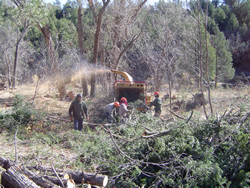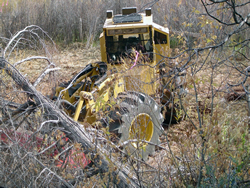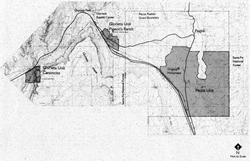
National Fire Plan Success Story
Fuels Reduction on Historic Pasture Lands
Pecos National Historical Park, New Mexico
National Fire Plan - Fuels Reduction
2009

Shredding coniferous trees and woody vegetation during Phase I.

Mulching vegetation removed during Phase II.

The project area is within the Pecos Unit of the park in San Miguel County, New Mexico. Click map to see a larger version.
Pecos National Historical Park has undertaken an ambitious program of manual and mechanical treatments to reduce hazardous fuels and restore historic pasturelands. Fuels reduction efforts have been primarily focused on removing the piñon pine and juniper that have invaded the pastures in the park over time.
Approximately 1,000 acres were treated in 2005. Two-hundred additional acres were treated during the summer of 2008 and another 350 acres were treated in the fall of 2008. In each instance, the work has been conducted in two phases. During Phase I, contractors use hand saws and chainsaws to remove most of the woody vegetation from cultural sites and fence lines found within and bordering the treatment area. Cut vegetation is then carried away by hand from the cultural sites and fence lines, to be shredded and spread across the treatment area by machinery. Seventy-five to one-hundred percent of the coniferous trees and other woody vegetation from the treatment area not included in Phase I, are then shredded and spread during Phase II.
A number of subject matter experts including entomologists and forest pest management specialists were consulted regarding concerns about the piñon ips bark beetle epidemic that has affected much of northern New Mexico in recent years. They determined that the timing of the treatment, tempered by other treatment parameters such as finely mulching and thinly spreading the cut vegetation, would not significantly contribute to an increase in the piñon ips population. Experts also made additional recommendations that were incorporated into the treatment guidelines.
Once a solid grass cover has been established, occasional prescribed burning will be used to discourage growth of woody vegetation and help maintain healthy pastures and open views that existed on the land when it was used as a cattle ranch.
By reestablishing and maintaining the pastures, the park will reduce the amount of fuels available to a wildfire, create “buffer zones” that will help firefighters control fires that do start and decrease the chance that a wildfire could move across the park’s boundary. Maintaining the pastures will also help prevent the potential of future damage to cultural resources from intensive wildfire and related suppression activities that result from unplanned fire events.
Contact: Dan Jacobs, Chief Park Ranger, (505) 757-7200.